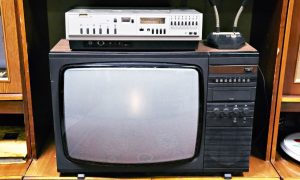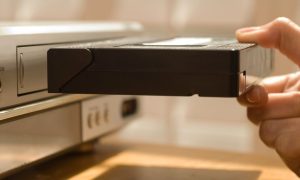When it comes to VHS and VCR, many people use the terms interchangeably, but they actually refer to two distinct components of the same video playback system. In this article, we’ll explore the key differences between VHS and VCR, explain how they work together, and provide a historical context for their role in the home entertainment industry.
What is a VCR?

A VCR, or Video Cassette Recorder, is an electronic device used to play and record video from VHS tapes. The VCR allows users to watch movies, record TV shows, and even record over previously recorded tapes. It’s the hardware part of the VHS system that interacts with the tape to provide video output on a television.
The VCR is equipped with features like play, rewind, fast forward, pause, and record, which allow users to control the playback and recording of video content. It also has a video head that reads the magnetic tape inside the VHS cassette, allowing for playback or recording of video and audio signals.
While the VCR was a staple of home entertainment for many years, it has been largely replaced by DVD players, Blu-ray players, and streaming services in modern times.
What is VHS?

VHS, which stands for Video Home System, is a magnetic tape format used for storing video and audio information. It was developed by JVC (Japan Victor Company) in the 1970s and became the dominant format for home video recording and playback.
A VHS tape consists of a spool of magnetic tape inside a plastic case. The tape is used to store video and audio information, which can then be played or recorded by a VCR. The tape is run over a set of magnetic heads inside the VCR, which read or write data onto the tape.
VHS tapes are used for recording television shows, movies, and other video content. They were popular from the 1980s until the early 2000s when digital formats like DVD and Blu-ray became the preferred choices for video storage.
VCR vs VHS: The Key Differences
While VCR and VHS are often thought of as being the same, they are two different things entirely:
-
VCR (Video Cassette Recorder): The VCR is the player and recorder—the device that operates the VHS tape. It allows users to watch, record, and rewind video content.
-
VHS (Video Home System): The VHS is the media—the tape that contains the video and audio content. It is played and recorded by the VCR.
In other words, the VCR is the technology that works with the VHS tape. The VCR has a set of mechanisms that read the video data encoded on the VHS tape and display it on a television.
How Did VCRs and VHS Tapes Work Together?
The VCR and VHS tape worked together as part of an integrated home video system. Here’s how they interacted:
-
Insert VHS Tape into VCR: The VHS tape, which contains recorded content, is inserted into the VCR.
-
Playback or Recording: The VCR either plays the content stored on the tape or records new content onto the tape. When playing, the VCR reads the magnetic data from the tape using a magnetic head and sends the signal to the TV for display.
-
Video Controls: The user can control playback, rewind, fast forward, pause, or stop the video using the VCR’s controls.
-
Recording: The VCR could also record television broadcasts or other video sources onto a blank VHS tape, using the same method of writing data onto the magnetic tape.
This process made VHS tapes and VCRs incredibly popular for home video recording and movie rentals from the 1980s through the 1990s.
The Rise and Fall of VHS and VCR
The VHS and VCR combination became the dominant format for home video during the 1980s and 1990s. It replaced earlier formats like Betamax, which had failed to gain the same level of market share. The widespread availability of VCRs and the growing popularity of VHS tapes made it easy for families to record their favorite TV shows and watch movies at home.
However, by the early 2000s, digital technologies like DVD and Blu-ray began to replace VHS tapes. Digital media offered better video and audio quality, more storage, and greater durability compared to the magnetic VHS tape. As a result, VCR sales declined, and VHS tapes were phased out in favor of more modern formats.
Today, VCRs and VHS tapes are considered obsolete technology, although they still have a nostalgic appeal and are sometimes used by collectors and enthusiasts.
Can a VCR Play Any VHS Tape?
In most cases, a VCR can play any VHS tape. However, there are a few things to consider when it comes to compatibility:
-
VHS Tape Types: There are different types of VHS tapes based on the recording format (e.g., SP, LP, and EP modes). SP (Standard Play) provides the best quality, while LP (Long Play) and EP (Extended Play) modes offer longer recording time at the expense of lower video quality. Most VCRs can play all of these formats, though the video quality may differ depending on the recording mode.
-
Region Codes: In some cases, VHS tapes were produced with region-specific encoding, especially for international releases. This may cause compatibility issues with VCRs from different regions. However, most VCRs can handle different formats and region codes.
Are VCRs and VHS Still Used Today?
Though VHS technology has been mostly replaced by digital formats, there is still a small community of collectors and enthusiasts who enjoy VHS tapes and VCRs. Vintage stores, flea markets, and online platforms often sell used VCRs and VHS tapes for those interested in nostalgic experiences.
For example, VHS tapes may still be used by people who want to preserve older, home-recorded content or those who enjoy the unique “retro” feel of analog video. Some filmmakers and video artists also experiment with VHS as a medium for its distinctive look and aesthetic.
That said, the general consumer use of VCRs and VHS tapes has significantly declined, as DVDs, Blu-ray, and streaming services have become the preferred way to watch movies and shows.
Conclusion
In conclusion, the VCR and VHS are two distinct elements of the same home video system. The VCR is the device used to play and record videos, while the VHS is the media format that stores the video content. Together, they revolutionized home entertainment in the 1980s and 1990s, making it possible for people to enjoy recorded and rented video content in the comfort of their homes.
Though VHS and VCR have largely been replaced by digital formats, they remain a part of pop culture and are still cherished by collectors and vintage tech enthusiasts. If you have any questions or memories about VCRs and VHS tapes, feel free to share them in the comments below!
I’ve been into SEO and blogging for over 7 years. I help websites show up higher on search engines. I really enjoy writing helpful guides, especially about gaming and tech stuff.
